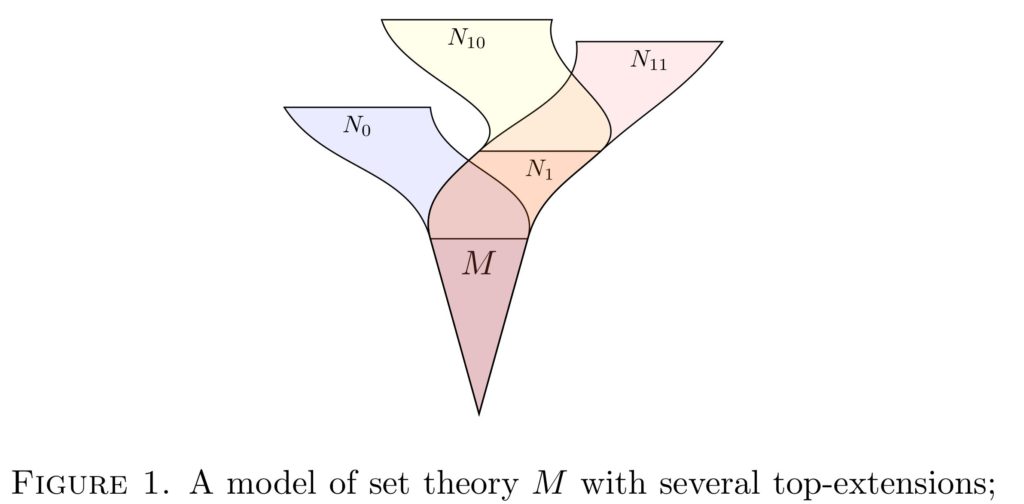[bibtex key=”HamkinsWoodin:The-universal-finite-set”]
Abstract. We define a certain finite set in set theory
and prove that it exhibits a universal extension property: it can be any desired particular finite set in the right set-theoretic universe and it can become successively any desired larger finite set in top-extensions of that universe. Specifically, ZFC proves the set is finite; the definition has complexity , so that any affirmative instance of it is verified in any sufficiently large rank-initial segment of the universe ; the set is empty in any transitive model and others; and if defines the set in some countable model of ZFC and for some finite set in , then there is a top-extension of to a model in which defines the new set . Thus, the set shows that no model of set theory can realize a maximal theory with its natural number parameters, although this is possible without parameters. Using the universal finite set, we prove that the validities of top-extensional set-theoretic potentialism, the modal principles valid in the Kripke model of all countable models of set theory, each accessing its top-extensions, are precisely the assertions of S4. Furthermore, if ZFC is consistent, then there are models of ZFC realizing the top-extensional maximality principle.
Woodin had established the universal algorithm phenomenon, showing that there is a Turing machine program with a certain universal top-extension property in models of arithmetic (see also work of Blanck and Enayat 2017 and upcoming paper of mine with Gitman and Kossak; also my post The universal algorithm: a new simple proof of Woodin’s theorem). Namely, the program provably enumerates a finite set of natural numbers, but it is relatively consistent with PA that it enumerates any particular desired finite set of numbers, and furthermore, if
I had inquired whether there is a set-theoretic analogue of this phenomenon, using
Main Question. Is there a universal
I had noticed in my earlier post that one can do this using a
Here, we provide a fully general affirmative answer with the following theorem.
Main Theorem. There is a formula
- ZFC proves that
- In any transitive model of \ZFC\ and others, this set is empty.
- If
By taking the union of the set defined by
We use this theorem to establish the fundamental validities of top-extensional set-theoretic potentialism.  Specifically, in the potentialist system consisting of the countable models of ZFC, with each accessing its top extensions, the modal validities with respect to substitution instances in the language of set theory, with parameters, are exactly the assertions of S4. When only sentences are considered, the validities are between S4 and S5, with both endpoints realized.
Specifically, in the potentialist system consisting of the countable models of ZFC, with each accessing its top extensions, the modal validities with respect to substitution instances in the language of set theory, with parameters, are exactly the assertions of S4. When only sentences are considered, the validities are between S4 and S5, with both endpoints realized.
In particular, we prove that if ZFC is consistent, then there is a model
This principle is true is any model of set theory with a maximal
Click through to the arXiv for more, the full article in pdf.
[bibtex key=”HamkinsWoodin:The-universal-finite-set”]



Pingback: The universal definition — it can define any mathematical object you like, in the right set-theoretic universe | Joel David Hamkins
Pingback: The universal finite set, Rutgers Logic Seminar, April 2018 | Joel David Hamkins
Pingback: The
Professor!
I am really confused about the fact that arbitrary union of universal finite set is universal set。does this basic fact use the union of end extension remains end extension what i think wrong.Could u explain me this point?Thanks!
The idea is simply that a finite set can have arbitrary-size sets as elements. For example, if you want to realize set A, then {A} is a finite set, whose union is A. So if you realize {A} as the universal finite set, then the union of this set will be A, and you have thereby realized A by the union process applied to the universal finite set.
Dear Professor!
Have been reading the papar you write,there are some obstacles in my thought.
1.In process A ,I can’t understand the finite set you define at every successful stage, does it just mean we search the first coded finite set in GCH pattern like the counterpart in PA ,or some given finite set we coded in GCH?
2.Assumed the correct understanding of “circular” definition of process as function ,why did you claim the existense of topped model is verifiable in next rank?
3.Any of powerset of beta_n preserving forcing didn’t creates fundamentally new models and preserves the same n ,kn,beta_n. I think there is bijection bewteen subset of beta_n and V_beta_n+1(wherr you use beth fixed point),so we can imply the new V_beta_n+1 has bijection onto the one in ground model.Right?
4.What the purpose of the divice such as beth fixed point and preserve-forcing in general sense?
Could i ask these questions in stackexchange?
I appreciate what you have clarified my confusion authenticly!